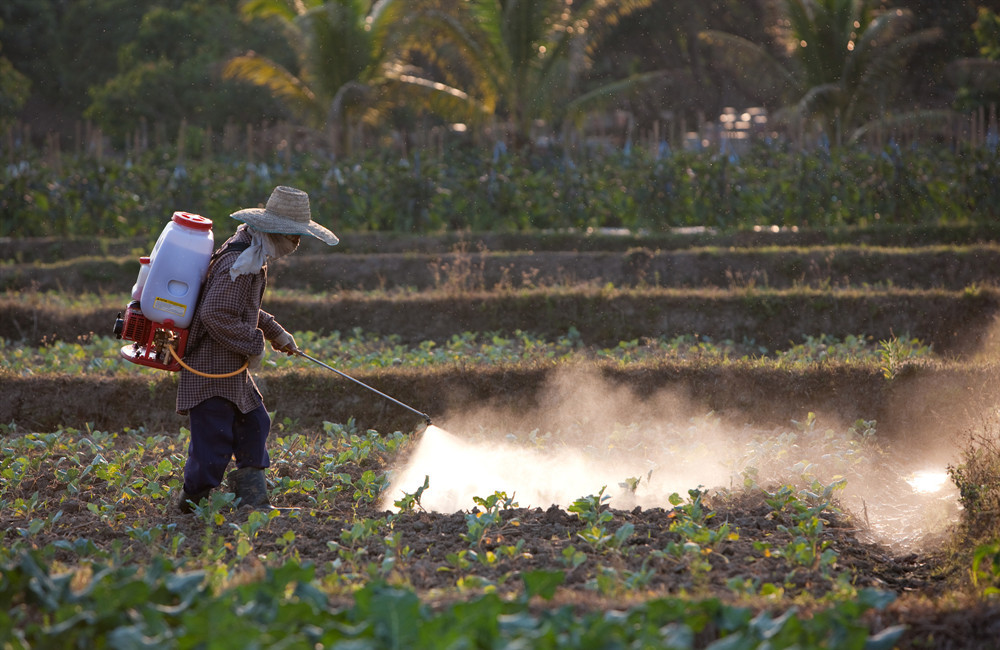The new standard for agricultural residues was issued to ensure food safety
Release time :
2021-06-24
A few days ago, the Ministry of Agriculture and Rural Affairs, the National Health Commission and the State Administration of Market Supervision and Administration jointly issued the National Food Safety Standard Maximum Residue Limit of Pesticides in Food (GB2763-2021).
A few days ago, the Ministry of Agriculture and Rural Affairs, the National Health Commission and the State Administration of Market Supervision and Administration jointly issued the National Food Safety Standard Maximum Residue Limit of Pesticides in Food (GB2763-2021). The new standard will be implemented on September 3, 2021. So far, China's pesticide residue limit standards will exceed 10000 items, fully covering the approved pesticide varieties and main plant-derived products in China. Food is the first priority of the people, and "safety on the tip of the tongue" has always been the focus of common concern of the whole society. So, what are the changes between the new standard and the old one? What positive role will the new standard play in ensuring the safety of agricultural products? How should ordinary consumers scientifically understand pesticide residues? To this end, the reporter interviewed the relevant heads of the Department of Quality and Safety Supervision of Agricultural Products of the Ministry of Agriculture and Rural Affairs.

Image source Visual China
Reporter: A few days ago, the Ministry of Agriculture and Rural Affairs released a news that China's pesticide residue limit standards exceeded 10000 items, comprehensively covering the approved pesticide varieties and main plant-derived products in China. There are many standards for agricultural disability. What practical role will it play in safeguarding "safety on the tongue"?
A: It is a necessary technical measure to use pesticides to control diseases, pests and weeds and ensure food security, which is also an internationally accepted practice. The use of pesticides will produce pesticide residues, no matter which country produces agricultural products. Since it cannot be avoided, countries ensure the quality and safety of agricultural products and avoid the possible harm of pesticide residues to human health by formulating the maximum residue limit standard of pesticides. With the increase of the number of MRLs for pesticides, more varieties of pesticides and agricultural products will be detected, the coverage of agricultural product quality and safety supervision will be wider, and the quality and safety of agricultural products will be more guaranteed.
81 new pesticide varieties were added, 2985 new residue limit standards were added, and 20 new food varieties (categories) were added. The standard coverage was wider. It will provide more powerful technical basis for agricultural product producers to strengthen quality control and for regulatory authorities to more accurately detect the potential safety hazards in food, and the "safety on the tongue" of the people will be more effectively guaranteed.
Reporter: What are the main changes between the new version of pesticide residue limit standard and the previous version?
A: The new version of pesticide residue limit standard issued this time stipulates 10092 MRLs for 564 pesticides in 376 kinds of food, and the number of standards has exceeded 10000 for the first time, nearly twice that of the Codex Alimentarius Commission (CAC). Compared with the 2019 version, 81 new pesticide varieties and 2985 residue limits were added; Compared with the 2014 version before the "13th Five-Year Plan", the number of pesticide varieties increased by 46% and the number of residue limits increased by 176%, which exceeded the construction task of the "13th Five-Year Plan" pesticide residue standard system proposed by the Ministry of Agriculture and Rural Affairs, marking that the formulation of pesticide residue standards in China has reached a new level, which will effectively guarantee the quality and safety of agricultural products in China, guide the scientific and rational use of agricultural production, and promote the healthy development of international trade in agricultural products.
Reporter: What is the current situation of pesticide residues in China? How are pesticide residues produced? How to reduce and control? In the production process, how to ensure that pesticide residues are up to standard from the source?
A: In recent years, the qualified rate of pesticide residues in the routine monitoring of the quality and safety of agricultural products in China is more than 97%. The quality and safety of agricultural products in China is generally controllable and remains at a high level.
Scientifically speaking, pesticide residue is an inevitable phenomenon after pesticide application. It refers to any specific substances that appear in agricultural products due to the use of pesticides, including pesticide derivatives that are considered to have toxicological significance, such as the transformation products, metabolites, reaction products and impurities of pesticides in plants. In fact, the safety of pesticide products was scientifically evaluated in the registration process, and reasonable use suggestions were put forward. Therefore, the quality and safety of agricultural products can be guaranteed as long as pesticides are used and harvested according to the requirements of product labels.
Of course, in the face of the basic national conditions in which agricultural production is dominated by small-scale farmers, we must adopt various means to improve scientific drug technology and maintain the safety of agricultural production, agricultural product quality and ecological environment. First, strengthen source control. Give full play to the leverage of pesticide registration and further optimize the structure of pesticide products. We will accelerate the elimination of highly toxic and high-risk pesticides, control low-level repetitive production, actively develop high-efficiency, low-toxic and low-residue pesticides, and encourage the registration of biological pesticides and characteristic small crops. Second, vigorously promote green prevention and control measures. Vigorously promote eco-friendly pesticides and dosage forms, gradually replace highly toxic and residual pesticides, and gradually replace the highly toxic pesticides that are still in use. At the same time, vigorously promote plant protection measures to replace pesticides, including the use of physical means such as natural enemy biology and light trapping, as well as the use of insect pheromone trapping and disorientation. Third, strengthen the training of efficient, safe and scientific pesticide application technology. Vigorously train farmers and grassroots technical personnel, improve their awareness and technology of safe and rational use of drugs, popularize scientific and rational use of drugs, reduce the abuse of pesticides, improve the prevention and control effect and reduce the use of pesticides. Fourth, vigorously develop professional service organizations. Through the development of specialized service organizations for diseases and insect pests, the level of specialization and scale of pesticide use will be improved, so that the application of pesticides will be more in line with the laws and requirements of disease and insect pest control, and the purpose of better scientific and rational drug use will be achieved.
Reporter: How should consumers scientifically understand pesticide residues in the consumption process? How to classify? What problems and aspects should consumers pay attention to when purchasing and processing fruits and vegetables?
A: Formulating MRLs is a technical means and common practice for international organizations and countries to strengthen pesticide residue control. Whether it is safe to eat agricultural products containing pesticide residues depends on the amount of pesticide residues, toxicity and consumption. Countries have increased the safety factor by at least 100 times when formulating the pesticide residue limit standard. Therefore, it is safe to use the pesticide residue below the standard.
Fresh agricultural products sold in regular places such as farmers' markets, supermarkets and community convenience food stations have undergone necessary testing procedures before being put on the shelves, and their quality and safety can be effectively guaranteed. Of course, consumers can use soaking, peeling, blanching and other cleaning methods according to the type of agricultural products and eating habits to achieve more hygienic purposes. At the same time, the quality and safety of agricultural products sold in informal places cannot be effectively guaranteed due to their unclear sources, so consumers are advised to buy them carefully.
Reporter: What are the current good practices for safeguarding the "safety on the tongue" of the masses?
In 2015, the Work Plan for Accelerating the Improvement of China's Pesticide Residue Standard System approved by the State Council carried out the top-level design for the formulation of China's pesticide residue standards during the "13th Five-Year Plan", and put forward the goals and requirements for completing 10000 items.
The 2021 version of GB2763 requires the "most rigorous standard" to set the residue limit scientifically, highlight the supervision of high-risk pesticides and key agricultural products, ensure the quality and safety of agricultural products in a wider range, and ensure the "safety on the tongue" of the people. First, highlight the supervision of high-risk pesticide varieties. 792 limit standards for 29 prohibited pesticides such as methamidophos and 345 limit standards for 20 restricted pesticides such as omethoate have been stipulated, achieving full coverage of plant-derived agricultural products and providing sufficient judgment basis for strict regulation of illegal and illegal use of prohibited pesticides. Second, highlight the supervision of fresh agricultural products. Fresh agricultural products such as vegetables and fruits are taking an increasing proportion in China's diet, and their quality and safety have attracted much attention. The new pesticide residue limit standard stipulates 5766 residue limits for fresh agricultural products such as vegetables and fruits, providing strong support for strengthening the quality and safety supervision of fresh agricultural products. Third, highlight the supervision of imported agricultural products. In view of the situation that imported agricultural products may contain pesticides that have not yet been registered in China, 1742 residue limits of 87 pesticides that have not yet been approved for use in China, except for the banned pesticides in China, have been formulated by evaluating and transforming the Codex Alimentarius standards, which provides a technical basis for better controlling the national level of food safety and is conducive to ensuring the consumption safety of imported food by the Chinese people.
The pesticide residue limit standards are formulated after scientific risk assessment based on the pesticide registration residue test and market monitoring data, residents' dietary consumption data, pesticide toxicology data, etc. The principles, methods and data requirements of dietary risk assessment of pesticide residues adopted in China have been in line with the Codex Alimentarius Commission (CAC) and Europe and the United States, ensuring the progressiveness of the standard. In order to ensure scientific, fair and open standards, the opinions of experts, users, consumers, relevant functional departments and the public were widely solicited during the formulation of the standards, and the members of the World Trade Organization were informed and accepted the evaluation of the scientific nature of the standards, ensuring that the standards not only effectively ensure the quality and safety of agricultural products, but also conform to the actual agricultural production in China.
(Source: China Food Safety Network)
Related News
2021-09-28


